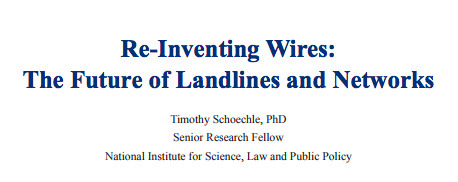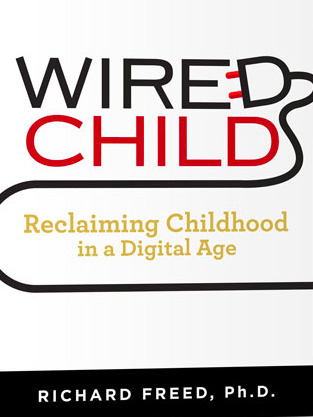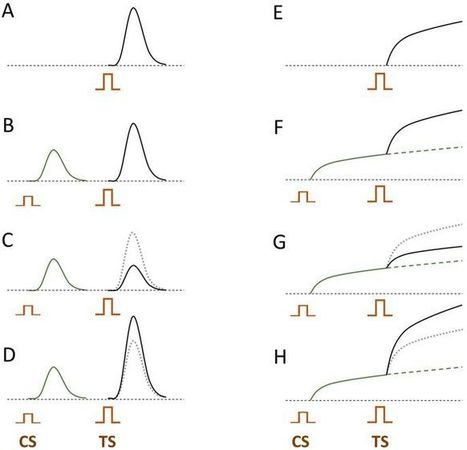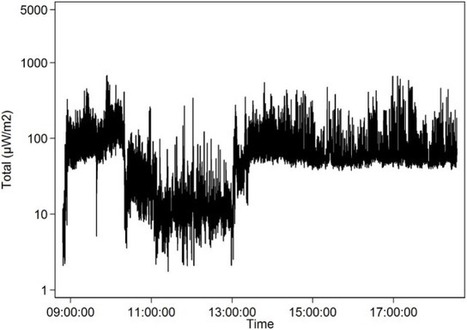 Your new post is loading...
 Your new post is loading...

|
Scooped by
Roxana Marachi, PhD
August 20, 2017 1:11 PM
|

|
Scooped by
Roxana Marachi, PhD
October 9, 2018 2:17 AM
|
By John C. Dvorak "The technology might be the problem, but even worse for the companies behind it is the perception that 5G is already unsafe before they even get it on a single pole." "If you read the barrage of scary literature about 5G mobile phone technology, specifically the use of millimeter wave frequencies to transmit data, you must conclude that it is a bad bet. I'm not saying this because the technology does not work. It's a bad bet because so little is known about the effects of millimeter waves (30GHz-300GHz). While these frequencies only permeate a small fraction of the human epidermis (the skin), the effect on the cornea, in particular, needs serious research. Because the industry is too cheap to study the health effects of the technology itself, it lets this sort of product out the door despite the fact that it has already been weaponized by the military. These frequencies are so poor at travelling long distances, they need a transmitter on nearly every telephone pole and light pole to make 5G work."... For full post, see: https://www.pcmag.com/article/345387/what-is-5gpcmag.com/commentary/363244/the-problem-with-5g

|
Scooped by
Roxana Marachi, PhD
October 3, 2017 3:21 PM
|
[For latest update on this story, see: http://sco.lt/4oFJpp] "Toymaker Mattel Inc. has announced plans to sell a nursery gadget that will listen to infants and watch over them, record their sleep patterns, and even play a lullaby should they awaken. Put another way: It eavesdrops on kids. Skeptics are asking if the device, similar to Amazon.com’s Echo with its Alexa voice assistant, will violate children’s privacy and deepen a trend of surrendering intimate human connections to technology that talks and listens. “The kid tech industry sees kids’ bedroom as an economic bonanza," said Jeff Chester, executive director of the Center for Digital Democracy, a Washington-based policy group that advocates for privacy protections. “They can get all kinds of profile information -- the kid likes to eat this kind of food, the kid likes to listen to this kind of music, and we’ll have this kind of information that we can share with partners and advertisers." The toymaker announced Aristotle in January as a “connected kids room platform.” The device includes a speaker, camera and lights. It’s powered by processors from Qualcomm Inc., and it uses programming from Microsoft Corp. to collect crib-side data and respond to a baby’s needs. Aristotle can be programmed to launch into a lullaby, emit white noise, or turn on a night light to soothe a waking baby back to sleep. The monitor sends data on nap times and diaper changes to a corresponding smartphone app and, with permission, uploads it to the cloud. The device can help purchase diapers, reinforce good manners in kids (by requiring the word "please" in voice commands) and even help kids learn a foreign language, the company said in a press release.
Aristotle was to be introduced at retail in the summer with a recommended price of $299, according to Mattel’s January news release. The product didn’t turn up in a search of Mattel’s shopping website on Thursday and the company hasn’t said when it will be available or if it’s been delayed.
Alex Clark, a spokesman for Mattel, said in an email the company is “committed to ensuring every product we make meets or exceeds all applicable laws and regulations, including connected products intended for children’s use.”
Aristotle wasn’t designed to store or record audio or video, Clark said. No third parties will have access to any personally-identifiable information, and any data shared is entirely anonymous and fully encrypted, he said. Listening MachinesThe trend toward talking, listening machines is accelerating. Amazon, girding for competition from Apple Inc. and Google in the race to equip homes with smart devices, this week unveiled a slew of consumer gadgets including an Alexa-powered digital-home hub and a smaller and cheaper Echo speaker. Mattel is investing in internet-connected toys under a new leader recruited from Google. “Alexa and Echo have prepared us to say this is OK -- to see something that’s actually quite shocking as OK,” Sherry Turkle, a professor at the Massachusetts Institute of Technology, said in an interview. She called Aristotle’s lullaby capability “exactly the wrong thing for a computer to be doing,” because the machine can’t provide the comfort a human would. In Congress, two lawmakers in a letter Thursday asked Mattel for details on how Aristotle will gather and store information. Protect Families“It appears that never before has a device had the capability to so intimately look into the life of a child,” Senator Ed Markey, a Massachusetts Democrat, and Representative Joe Barton, a Texas Republican, said in the letter.
“Consumers should know how this product will work, and what measures Mattel will take to protect families’ privacy and secure their data,” the lawmakers wrote. Their questions included whether Aristotle will always be on to record children, and how Mattel will store and protect the information.
Mattel is “carefully reviewing” the letter, said Clark, the company spokesman.
The El Segundo, California-based toymaker in its announcement of the product said it paid “special attention” to federal law that requires websites and apps targeted at children to gain parental consent to collect and use children’s personal information.
But Chester, with the Center for Digital Democracy, said the law doesn’t protect children once parents give permission.
Mattel Chief Executive Officer Margo Georgiadis, hired from Alphabet Inc.’s Google early this year, has laid out a vision for the 72-year-old company that puts more emphasis on internet-connected devices over traditional toys.
This mission has taken on new urgency as interest appears to be waning in once-powerful brands such as Thomas and American Girl. Shares have dropped by more than 40 percent this year. But electronics come with implications far beyond selling wooden train sets or dress-up dolls.
"A young child’s bedroom should not be a place for corporate surveillance and data-gathering," said Josh Golin, executive director of the Campaign for a Commercial-Free Childhood policy group.
— With assistance by Matthew Townsend" For original post, please see https://www.bloomberg.com/news/articles/2017-09-29/mattel-nursery-gadget-listens-to-babies-sets-off-privacy-alarms
"ALBANY, N.Y. October 10, 2017 -- Americans spend a startling amount of time on our smart phones and mobile devices. According to emarketer, U.S. adults will spend about more than four hours per day using apps or surfing the web from a mobile device in 2017. The number rises as the population segment gets younger: The 18-to-24 demographic spends significantly more time on their devices than older adults. But what about children’s use of smart devices? And how are mobile devices used among k-12 students? These are the questions posed in a recently published special section of Child Development, edited by the University at Albany’s Zheng Yan and Örebro University’s Lennart Hardell. The section shows how particularly diverse the use of mobile technology is among children and adolescents, and points to great complexity in the effects of that usage. It includes articles from national and international scholars on the complicated impact mobile technology has on infants, toddlers, children, teens and parents. “There are nearly three billion children and adolescents in the world,” said Yan, an associate professor of educational and counseling psychology in the School of Education. “Most of them were, are, or will be various types of mobile technology users, interacting with and being influenced by mobile technology in numerous ways.” The articles in this special section, Contemporary Mobile Technology and Child and Adolescent Development,” consider the effects on a wide range of outcomes including: - Risks of using mobile phones while driving, walking, and bicycling;
- Risks of radiation in mobile phone use for brain development;
- Effects of mobile technology on cognitive control and attention in contexts such as parenting and early brain development;
- Risks of sexting /increased risky behavior through peer pressure and social media Interaction;
- Effects of mobile technology use on sleep, mood, and mental health;
- Potential for monitoring children’s locations/children’s attitudes towards security and
- monitoring through GPS tracking; and
- Increased connectivity across spaces and cultures
Findings point to a range of outcomes including areas where mobile technology may pose potential dangers, and areas where development may be supported. An important example is the work summarized by Dr. Lennart Hardell concerning radiation and brain development. In terms of potential benefits to development, mobile technology offers new, unique ways for young children to maintain contact with family members not physically present. “Today’s mobile technologies have become a very unique and powerful influence on child and adolescent development,” said Yan. “Its use is very personal for children and adolescents, occurs almost anywhere and anytime, and integrates telephone, television, video games, personal computers, the Internet, and many new technologies into a portable device. The evidence indicates complex impacts on young mobile technology users.” The Society for Research in Child Development (SRCD) was established in 1933 by the National Research Council of the National Academy of Sciences. The Society’s goals are to advance interdisciplinary research in child development and to encourage applications of research findings. Its membership of more than 5,700 scientists is representative of the various disciplines and professions that contribute to knowledge of child development. In addition to Child Development, SRCD also publishes Monographs of the Society for Research in Child Development, Child Development Perspectives, and the SRCD Social Policy Report." For full post, see:
http://www.albany.edu/news/82329.php

|
Scooped by
Roxana Marachi, PhD
June 30, 2018 7:42 PM
|
By Andrew Crocker and Jennifer Lynch, June 22nd, 2018 "The Supreme Court handed down a landmark opinion today in Carpenter v. United States, ruling 5-4 that the Fourth Amendment protects cell phone location information. In an opinion by Chief Justice Roberts, the Court recognized that location information, collected by cell providers like Sprint, AT&T, and Verizon, creates a “detailed chronicle of a person’s physical presence compiled every day, every moment over years.” As a result, police must now get a warrant before obtaining this data. This is a major victory. Cell phones are essential to modern life, but the way that cell phones operate—by constantly connecting to cell towers to exchange data—makes it possible for cell providers to collect information on everywhere that each phone—and by extension, each phone’s owner—has been for years in the past. As the Court noted, not only does access to this kind of information allow the government to achieve “near perfect surveillance, as if it had attached an ankle monitor to the phone’s user,” but, because phone companies collect it for every device, the “police need not even know in advance whether they want to follow a particular individual, or when.” For years, the government has argued that the sensitive nature of this data doesn’t matter; the mere fact that it’s collected by phone companies makes it automatically devoid of constitutional protection."... For full post, see: https://www.eff.org/deeplinks/2018/06/victory-supreme-court-says-fourth-amendment-applies-cell-phone-tracking

|
Scooped by
Roxana Marachi, PhD
May 4, 2018 2:53 AM
|
"Silicon Valley’s philosophy to “move fast and break things” may not be readily apparent upon landing on the Smart Cities Vision page for San José, but a closer look at key proposals reveals it’s likely in the mix. While difficult to know how day-to-day life will change as a result of living in a “smart city,” the issues described below are certainly worth learning more about. What should residents expect as tangible benefits? What will be the costs? What blind spots may exist among well-intentioned leaders making decisions, and will there be unintended (or consciously dismissed) harms resulting from these initiatives?
A precise definition of a “Smart City” remains elusive, yet what does appear at the root, is that 5G will be involved. A recent Bloomberg update documents tensions between big business and government in the rollout of 5G, with a focus on San Jose’s role in initially participating with, and then protesting, the Broadband Deployment Advisory Committee of the FCC. It appears despite the recent resistance, that industry dominance is not solely an issue within the FCC, but also influential in shaping local policies for 5G deployment. …”For San Jose, the march toward 5G continues without the FCC. On Monday, the city struck an agreement with AT&T to install about 200 small-cell devices for 5G on light poles in exchange for $5 million in lease revenue over 15 years. Perhaps the worst part of the whole process, said San Jose Mayor Liccardo, is that most Americans aren’t paying attention: “When you’re talking about complex issues of technology and regulation, it’s often lost on the public just how badly they’re being screwed.”
According to a February 2018 report by Grand View Research, Inc., the global smart cities market is anticipated to reach approximately 2.6 trillion dollars by 2025. A summary of the report indicates key industry participants to include tech giants such as Accenture, Cisco Systems, Siemens, IBM, General Electric, and Microsoft. What appears missing in the summary, however, is the specific situation for San José, where apparently Facebook will also be a main driver and beneficiary of the Smart Cities plan.
A quote from the Smart City Team’s presentation on the Facebook Terragraph (Millimeter Wave Technology) indicates that “deploying at scale in a city has never been done before.” See the following overview here: “Introducing Facebook’s new terrestrial connectivity systems — Terragraph and Project ARIES” and this video introduction. To learn more about Facebook’s partnership with San José, see this link to documents from the April 5th Smart Cities Meeting). Below is a list of concerns related to the Smart Cities and 5G rollouts. More specific questions are provided at the end of this post. A. Public Health Impacts:
1. Scientists and Doctors Demand Moratorium on 5G (original)
(Örebro, Sweden) Sept. 13, 2017 “Over 180 scientists and doctors from 35 countries sent a declaration to officials of the European Commission today demanding a moratorium on the increase of cell antennas for planned 5G expansion. Concerns over health effects from higher radiation exposure include potential neurological impacts, infertility, and cancer.” The following site http://bit.ly/5Gscienceappeal includes a statement from the International Society of Doctors for the Environment as of April 2018 also urging a halt to the rollout of 5G. There are now over 200 signatories to the original appeal. See the main website here.".. For full post, see here:
https://eduresearcher.com/2018/05/02/smartcity/

|
Scooped by
Roxana Marachi, PhD
January 26, 2018 1:32 PM
|
"WASHINGTON--(Business Wire)
A public policy report on the Internet and the future of landlines and wireless networks, “Re-Inventing Wires: The Future of Landlines and Networks,” was published online today by the National Institute for Science, Law & Public Policy (NISLAPP) in Washington, D.C. Because broadband networks and the Internet have become vital components of our nation’s physical, cultural and social structure, the future of these networks, the report says, must be steered towards the fastest, most reliable and future-proof, and secure infrastructure available. Such infrastructure would be wired, not wireless.
Dr. Timothy Schoechle, author of the report and Senior Research Fellow at NISLAPP, says, “We are seeing the present national emphasis on wireless technologies because the 'triopoly' of Verizon, AT&T, and Comcast that dominates our access to the Internet imposes artificial scarcity, planned obsolescence, and high prices to maintain their immense profits. It is in their interest to obscure the fact that advanced copper and optical fiber are far superior to wireless in both cost and performance.” From a broad analysis of available data, “Re-Inventing Wires: The Future of Landlines and Networks” demonstrates wireless systems cannot provide long-term solutions for universal, reliable and affordable Internet accessibility, nor support the ever-increasing data rates that will be needed in the near future for each American home and business. Investment in wired, not wireless, information infrastructure is needed across the U.S. right now. Schoechle says, “Government officials have been misled about the adequacy of wireless communications. Legislators should stop enabling the wireless industry’s plans for massive new deployments of 4G LTE and soon 5G millimeter wave antennas throughout American neighborhoods, and instead commit to supporting reliable, energy-efficient and enduring hard-wired telecommunications infrastructure that meets the nation’s immediate and long-term needs.” “Re-Inventing Wires: The Future of Landlines and Networks” explains why on technological, and other grounds, including the energy guzzling nature of wireless antennas and networks, an intensely wireless approach to communications, now being planned by the wireless industry, is the wrong direction, and very clearly not in the public’s best interest. “Largely due to failures and consequences of the Telecommunications Act of 1996,” Schoechle says, “the Internet is not living up to its potential. It has been hijacked by the commercial motivations that have come to re-define and constrain the availability, quality, content, and media of high-speed access in the United States.... While other countries are investing to assure citizens’ access to a fast and reliable information highway, U.S. legislators appear asleep at the switch, captured by the wireless industry and its lobbyists.” Importantly, “Reinventing Wires: The Future of Landlines and Networks” explains the renaissance that has occurred in wired technologies in recent years and how these advances offer tremendous potential for America’s sustainable connectivity of the future, one that is fast, equitable, safe, secure, and energy-efficient. The paper, “Re-Inventing Wires: The Future of Landlines and Networks,” will be presented as part of a panel at The Commonwealth Club of California, Monday, February 5th at 5:30 p.m. in San Francisco, CA. Contacts: National Institute for Science, Law & Public Policy (NISLAPP)
Camilla Rees, MBA, Senior Policy Advisor
(917)-359-8450
or
NISLAPP
Timothy D. Schoechle, PhD
Senior Research Fellow
(303) 443-5490" ___________________________ https://www.businesswire.com/news/home/20180126005137/en Download “Re-Inventing Wires: The Future of Landlines and Networks” Download—Press Release – Long Form

|
Scooped by
Roxana Marachi, PhD
June 4, 2018 4:45 AM
|
Grace Macaskill "Top mobile firms are warning shareholders about the potential health risks of phones but keeping the information from customers. Companies including Blackberry, EE, Nokia and Vodafone have told investors they could face legal action from device users if research eventually finds links between their products and cancer.
Yet they fail to warn users of any potential risk in their ads and packaging. British Telecom, which owns EE, tells investors starkly in its 2017 annual report: “We can’t provide absolute assurance that research in the future won’t establish links between radio frequency emissions and health risks.” And Nokia says: “There have been some research results that indicated the possibility that electromagnetic waves emitted from mobile devices and base stations have adverse health effects, such as increasing the risk of cancer.” The news comes after we revealed brain cancer patient Neil Whitfield, 60, is the first Briton to sue a phone maker and could win up to £1million from Nokia if successful. Mr Whitfield said: “If companies are warning investors there is a possible risk they should be warning people who use their phones and networks. "They are being selective with the truth and have decided those with money are more important than the general public.”... For full post, see: https://www.mirror.co.uk/news/uk-news/top-mobile-phone-firms-warning-12637044

|
Scooped by
Roxana Marachi, PhD
August 27, 2017 12:24 PM
|

|
Scooped by
Roxana Marachi, PhD
April 15, 2018 7:32 PM
|
"AppCensus is created by an international collaboration of researchers with combined expertise in the fields of networking, privacy, security, and usability. We're centered in Berkeley, California. Our mission is to give app users better transparency into how their mobile apps use and misuse their personally identifying information. We want to explore whether apps are following standard best practices when handling private data. We hope that by giving out this transparency, we will foster a better mobile app ecosystem, because users are exposed to hidden privacy costs and app developers are better made aware of best practices for their future apps." To app privacy analysis visit tool, click here: https://www.appcensus.mobi

|
Scooped by
Roxana Marachi, PhD
December 30, 2017 8:35 PM
|
Abstract "Children’s use of electronic media, including Internet and video gaming, has increased dramatically to an average in the general population of roughly 3 h per day. Some children cannot control their Internet use leading to increasing research on ‘‘internet addiction.’’ The objective of this article is to review the research on ADHD as a risk factor for Internet addiction and gaming, its complications, and what research and methodological questions remain to be addressed. The literature search was done in PubMed and Psychinfo, as well as by hand. Previous research has demonstrated rates of Internet addiction as high as 25% in the population and that it is addiction more than time of use that is best correlated with psychopathology. Various studies confirm that psychiatric disorders, and ADHD in particular, are associated with overuse, with severity of ADHD specifically correlated with the amount of use. ADHD children may be vulnerable since these games operate in brief segments that are not attention demanding. In addition, they offer immediate rewards with a strong incentive to increase the reward by trying the next level. The time spent on these games may also exacerbate ADHD symptoms, if not directly then through the loss of time spent on more developmentally challenging tasks. While this is a major issue for many parents, there is no empirical research on effective treatment." https://link.springer.com/content/pdf/10.1007%2Fs12402-011-0065-z.pdf

|
Scooped by
Roxana Marachi, PhD
April 4, 2018 5:55 PM
|
Abstract "Wireless-enabled headsets that connect to the internet can provide remote transcribing of patient examination notes. Audio and video can be captured and transmitted by wireless signals sent from the computer screen in the frame of the glasses. But using wireless glass-type devices can expose the user to a specific absorption rates (SAR) of 1.11–1.46 W/kg of radiofrequency radiation. That RF intensity is as high as or higher than RF emissions of some cell phones. Prolonged use of cell phones used ipsilaterally at the head has been associated with statistically significant increased risk of glioma and acoustic neuroma. Using wireless glasses for extended periods to teach, to perform surgery, or conduct patient exams will expose the medical professional to similar RF exposures which may impair brain performance, cognition and judgment, concentration and attention and increase the risk for brain tumors. The quality of medical care may be compromised by extended use of wireless-embedded devices in health care settings. Both medical professionals and their patients should know the risks of such devices and have a choice about allowing their use during patient exams. Transmission of sensitive patient data over wireless networks may increase the risk of hacking and security breaches leading to losses of private patient medical and financial data that are strictly protected under HIPPA health information privacy laws." https://www.tandfonline.com/doi/abs/10.1080/15368378.2017.1422261?journalCode=iebm20 Sage C., and Hardell L. (2018). Fatal collision? Are wireless headsets a risk in treating patients? Electromagnetic Biology and Medicine, DOI:10.1080/15368378.2017.1422261.

|
Scooped by
Roxana Marachi, PhD
April 22, 2018 5:20 PM
|
|

|
Scooped by
Roxana Marachi, PhD
April 22, 2018 5:29 PM
|
"A practical guide to building your child’s bond with family and fostering school success amid the allure of digital screens Kids’ obsessive use of video games, social media, and texting is eclipsing their connections with family and school—the two most important contributors to their well-being. The result: a generation of kids who suffer from soaring rates of emotional and academic problems, with many falling prey to an epidemic of video game and internet addictions. In Wired Child, learn why a bevy of social media friends won’t keep teens from feeling empty inside and turning to cutting for relief. See how our kids have become smartphone experts who struggle in reading, math, and the other educational basics that colleges consider in deciding admissions. And discover how many “child-friendly” technologies are depriving kids of joy in the real world, putting them at risk for device addictions."... http://richardfreed.com/

|
Scooped by
Roxana Marachi, PhD
June 24, 2018 12:37 AM
|

|
Scooped by
Roxana Marachi, PhD
July 26, 2018 12:55 AM
|
Abstract "While a good number of studies have demonstrated that modern, man-made ambient electromagnetic fields can have both stimulatory and inhibitory effect on immune system function, the precise mechanisms have yet to be completely elucidated. It is hypothesized here that, depending on the parameters, one of the means by which long-term electromagnetic field exposure has the potential to eventually lead to immunosuppression is via downstream inhibition of the enzyme calcineurin - a protein phosphatase, which activates the T-cells of the immune system and can be blocked by pharmaceutical agents. Calcineurin is the target of a class of pharmaceuticals called calcineurin inhibitors (e.g., cyclosporine, pimecrolimus and tacrolimus). When organ transplant recipients take such pharmaceuticals to prevent or suppress organ transplant rejection, one of the major side effects is immunosuppression leading to increased risk of opportunistic infection: e.g., fungal, viral (Epstein-Barr virus, cytomegalovirus), atypical bacterial (Nocardia, Listeria, mycobacterial, mycoplasma), and parasitic (e.g., toxoplasmosis) infections. Frequent anecdotal reports, as well as a number of scientific studies, have shown that electromagnetic field exposures may indeed produce the same effect: a weakened immune system leading to an increase in the same or similar opportunistic infections: i.e., fungal, viral, atypical bacterial, and parasitic infections. Furthermore, numerous research studies have shown that man-made electromagnetic fields have the potential to open voltage-gated calcium channels, which can in turn produce a pathological increase of intracellular calcium, leading downstream to the pathological production of a series of reactive oxygen species. Finally, there are a number of research studies demonstrating the inhibition of calcineurin by a pathological production of reactive oxygen species. Hence, it is hypothesized here that exposures to electromagnetic fields have the potential to inhibit immune system response by means of an eventual pathological increase in the influx of calcium into the cytoplasm of the cell, which induces a pathological production of reactive oxygen species, which in turn can have an inhibitory effect on calcineurin. Calcineurin inhibition leads to immunosuppression, which in turn leads to a weakened immune system and an increase in opportunistic infection.
KEYWORDS: Calcineurin; Calcineurin inhibitors; Electromagnetic fields (EMF); Immunosuppression; Opportunistic infections; Reactive oxygen species (ROS)
https://www.ncbi.nlm.nih.gov/pubmed/28818275

|
Scooped by
Roxana Marachi, PhD
June 25, 2018 12:55 PM
|
Abstract
"We demonstrate that conditioning of mammalian cells by electroporation with nanosecond pulsed electric field (nsPEF) facilitates their response to the next nsPEF treatment. The experiments were designed to unambiguously separate the electroporation-induced sensitization and desensitization effects. Electroporation was achieved by bursts of 300-ns, 9 kV/cm pulses (50 Hz, n = 3–100) and quantified by propidium dye uptake within 11 min after the nsPEF exposure. We observed either sensitization to nsPEF or no change (when the conditioning was either too weak or too intense, or when the wait time after conditioning was too short). Within studied limits, conditioning never caused desensitization. With settings optimal for sensitization, the second nsPEF treatment became 2.5 times (25 °C) or even 6 times (37 °C) more effective than the same nsPEF treatment delivered without conditioning. The minimum wait time required for sensitization development was 30 s, with still longer delays increasing the effect. We show that the delayed hypersensitivity was not mediated by either cell swelling or oxidative effect of the conditioning treatment; biological mechanisms underlying the delayed electrosensitization remain to be elucidated. Optimizing nsPEF delivery protocols to induce sensitization can reduce the dose and adverse side effects of diverse medical treatments which require multiple pulse applications. For full post, see: https://www.nature.com/articles/s41598-017-10825-w

|
Scooped by
Roxana Marachi, PhD
May 4, 2018 2:03 AM
|
Abstract
Introduction: Wireless access to the Internet is now commonly used in schools. Many schools give each student their own laptop and utilize the laptops and wireless fidelity (Wi-Fi) connection for educational purposes. Most children also bring their own mobile phones to school. Since children are obliged by law to attend school, a safe environment is important. Lately, it has been discussed if radio-frequency (RF) radiation can have long-term adverse effects on children’s health.
Method: This study conducted exposimetric measurements in schools to assess RF emissions in the classroom by measuring the teachers’ RF exposure in order to approximate the children’s exposure. Teachers in grades 7–12 carried a body-borne exposimeter, EME-Spy 200, in school during 1–4 days of work. The exposimeter can measure 20 different frequency bands from 87 to 5,850 MHz.
Results: Eighteen teachers from seven schools participated. The mean exposure to RF radiation ranged from 1.1 to 66.1 µW/m2. The highest mean level, 396.6 µW/m2, occurred during 5 min of a lesson when the teacher let the students stream and watch YouTube videos. Maximum peaks went up to 82,857 µW/m2 from mobile phone uplink.
Discussion: Our measurements are in line with recent exposure studies in schools in other countries. The exposure levels varied between the different Wi-Fi systems, and if the students were allowed to use their own smartphones on the school’s Wi-Fi network or if they were connected to GSM/3G/4G base stations outside the school. An access point over the teacher’s head gave higher exposure compared with a school with a wired Internet connection for the teacher in the classroom. All values were far below International Commission on Non-Ionizing Radiation Protection’s reference values, but most mean levels measured were above the precautionary target level of 3–6 µW/m2 as proposed by the Bioinitiative Report. The length of time wireless devices are used is an essential determinant in overall exposure. Measures to minimize children’s exposure to RF radiation in school would include preferring wired connections, allowing laptops, tablets and mobile phones only in flight mode and deactivating Wi-Fi access points, when not used for learning purposes.
Keywords: radiofrequency radiation, wireless fidelity, Wi-Fi, exposimetric measurements, schools, children, health

|
Scooped by
Roxana Marachi, PhD
January 28, 2018 11:03 PM
|
"Norwegian telecoms regulator Nkom said it had examined eighteen models of smart watch for children, and found that not a single one of them complied with national regulations on documentation for radio equipment safety. It said the dealers and importers had not carried out sufficiently thorough checks of the devices before bringing them to market. Nkom looked at the devices themselves, their packaging, documentation and customer information. Nkom said the shortcomings ranged from the absence of the 'CE' European safety standard marking, lack of manufacturer or type designation, and lack of testing documentation. Many of them lacked any indication of radiation testing. The regulator will be sending out notifications to the dealers and importers and in most cases, they and the producers will have the opportunity to propose a resolution to correct the shortcomings. Watches that do not fulfill requirements could be transmitting on the wrong wavelength, could interfere with other equipment and could be emitting unsafe levels of radiation."... For main post, see: https://www.telecompaper.com/news/nkom-says-18-child-smart-watches-fail-norwegian-safety-documentation-standards--1227862

|
Scooped by
Roxana Marachi, PhD
June 12, 2018 4:14 PM
|
By Benjamin Fineman and Nick Lewis "The increasingly rapid pace of technological advancement presents continual opportunities — and challenges — for the research and education communities. Most recently, advances in head-mounted displays (HMDs) for both virtual reality (VR) and augmented reality (AR) have made dramatic improvements in the devices' efficacy and affordability. Since the early 1990s, higher education has been experimenting with VR, which is a computer-generated environment that simulates a realistic experience. Historically, however, these efforts have been focused on large room-scale systems driven by dozens of displays and computers (such as cave automatic virtual environments). Because these efforts were extraordinarily expensive and required experts to operate them, their deployment was primarily limited to large research institutions. AR, which offers a live view of a physical, real-world environment that has computer-augmented elements, has been an area of interest since Harvard's Ivan Sutherland created a rudimentary AR headset in 1968. AR has been difficult to implement, however, and the required processing power, real-time 3D spatial mapping, and display technology have all been historically insufficient to create high-quality AR experiences.
Today, new HMDs can provide these high-quality immersive experiences at consumer price points, reducing costs by almost two orders of magnitude. Because of this paradigm shift, VR and AR are poised to become an integral part of the higher education technology environment; on some campuses, this is already the case. Integrating VR and AR in higher education makes possible many applications. However, their use also raises security issues. Researchers at the University of New Haven, for example, have demonstrated a vulnerability that let an attacker trick a VR user into crashing into a wall. In another case, a University of California, Davis, researcher showed that VR tracking sensors can be compromised to allow attackers to peek into the user's physical space. To successfully address both existing and forthcoming VR/AR security risks, institutions must understand those risks and apply general security principles to mitigate them...." For full post, please see: https://er.educause.edu/articles/2018/5/securing-your-reality-addressing-security-and-privacy-in-virtual-and-augmented-reality-applications

|
Scooped by
Roxana Marachi, PhD
May 1, 2018 12:50 AM
|

|
Scooped by
Roxana Marachi, PhD
January 4, 2018 11:39 PM
|
[To download, click on title or arrow above or link below] "In June, 2009, the Division of Environmental and Occupational Disease Control in the California Department of Public Health (CDPH) prepared a draft cell phone safety guidance document. Although the document reflected the consensus of the division, it was not released until May, 2017 pursuant to a court order--the outcome of a lawsuit filed under the California Public Records Act. In December, 2017, the CDPH finally published their cell phone safety guidance document.
A side-by-side comparison of the contents of the original 2009 draft with the 2017 published version of the document appears below. The side-by-side can be downloaded at http://bit.ly/CDPHsidebyside.
"This is a guest post by Eugene Stern, originally posted on his blog sensemadehere.
'My friend Cathy O’Neil just sent me an article she wrote for the NY Times reviewing two books by technologists about virtual reality (VR). Part of her take was that neither book talked enough about ways that VR could be abused, and she speculated that worrying about VR was still mostly the provenance of science fiction writers (think Star Trek) rather than technologists.
I’m pretty comfortable around both sci-fi and technology, but you really don’t need to be an expert in either to worry about how VR could upend our lives and civilization. Just some sense of recent history is enough. If you think that massive computational power, the internet, and smartphones might have turned out to be a bit more than we bargained for, maybe it’s time to consider how amazingly well-positioned VR is to amplify some of the most troublesome aspects of the technology revolution: Personalization. We’ve learned over the last quarter century that we don’t mind being monitored (cookies, GPS, Fitbits), just as long as some benefits (recommendations, special offers, traffic advice, a tailored Facebook feed, the ability to broadcast our 5.4 mile running route to all our friends) come from crunching the resulting data. Never mind who might be storing all that data or what they might be doing with it. Now think about VR, which massively scales up both the amount of data and the ability to collect it. On one hand, VR is an immersive experience, generated by high dimensional data sets (indeed, one of the uses of VR is as a tool to allow us to navigate data sets that are otherwise too complex to make sense of; see here or here or here). On the other, VR is delivered through a device, which can be used to track eye movements, and VR technology to monitor other biometrics like heart rate, pulse, and electrical activity in the brain is already on the way (see here or here). You’ve probably heard of Google’s A/B tests, which enable web designers to vary individual aspects of a web page and track how people respond. Now imagine such tests in VR space, targeted at each individual user, and able both to vary all kinds of stimuli affecting all the senses, and to measure all kinds of response. In a contest between your family, friends, and VR set over who knows you better, it’s hard to see the humans having a chance. Addictiveness. By now it’s sort of a cliche to hear a technologist speak thoughtfully about how they won’t let their children near smartphones or Instagram until they’re in high school, or to read articles about internet use sprinkled with multiple mentions of dopamine. Won’t this all seem quaint in a few years, when internet porn gives way to (personalized!) VR sex, and your social network can deliver a full VR simulation of your crush’s reaction to the cute photo you just posted, not just a stylized thumbs-up or heart. Um, yeah, VR is going to make the virtual world way more addictive. “Why go into the outside world at all, it’s such a fright,” as Black Flag sang, to their televisions, and that was at least two whole generations of technology ago! Marketing. I was born in the Soviet Union, which had no ads, and it always felt strange to me that our entire media landscape (or, today, our entire information landscape) was driven by companies inserting little messages meant to sell you things. For one thing, I was always a bit skeptical that advertising was actually worth it. Well, with VR, there’ll be no question, because we’ll be able to track the outcomes of ads so precisely: eyeballs widen, heart rate rises just a bit, electrical activity heightens in the buying center of the brain (which by this time we will have effectively mapped, using — what else — VR technology). Advertisers will know exactly which ads worked (so the economy will make sense!), and, with predictive analytics and the heavy volumes of data attached to VR, they’ll also know which ads will work, for any given person. And lots of them will, because VR’s ability to virtually sample any product you might imagine might make it the most effective advertising medium ever. If today we think about ads as delivering eyeballs and clicks, in the age of VR, they might be delivering (virtual) wallets directly. Will users object? One more thing we’ve learned in the internet age is that people don’t seem to mind being targeted with ads across their entire virtual experience. Ad-based media still dominate, while raising revenues via direct subscription works for a few niche publications at best. The internet is funded by advertising. Why wouldn’t VR be?"... For full post, see:
https://mathbabe.org/2018/02/05/guest-post-what-we-should-worry-about-when-we-worry-about-virtual-reality/

|
Scooped by
Roxana Marachi, PhD
March 19, 2018 1:06 AM
|

|
Scooped by
Roxana Marachi, PhD
March 30, 2018 7:57 PM
|
|
 Your new post is loading...
Your new post is loading...
 Your new post is loading...
Your new post is loading...





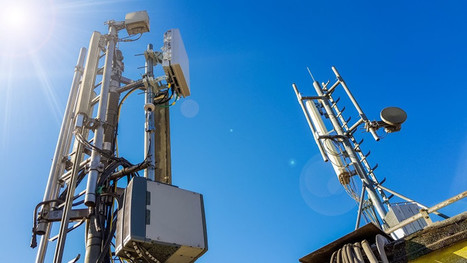
![Mattel "Aristotle" Gadget Listens to Babies, Setting Off Privacy Alarms // Bloomberg [Updated 10/4, Aristotle Discontinued] | Screen Time, Tech Safety & Harm Prevention Research | Scoop.it](https://img.scoop.it/sT4quBtyK4ufkOC36KlNnDl72eJkfbmt4t8yenImKBVvK0kTmF0xjctABnaLJIm9)



